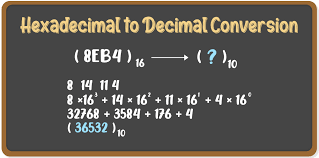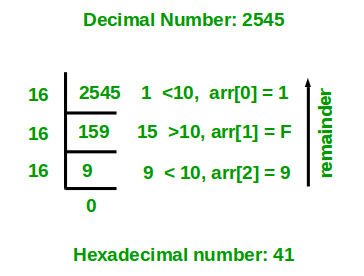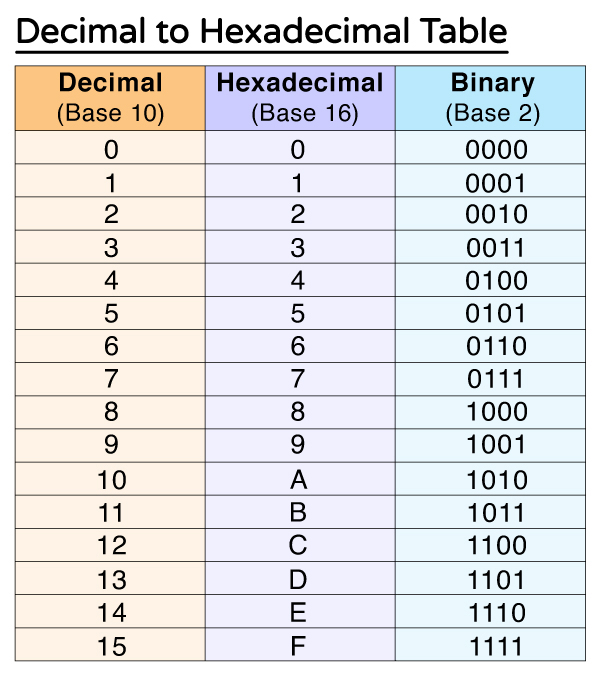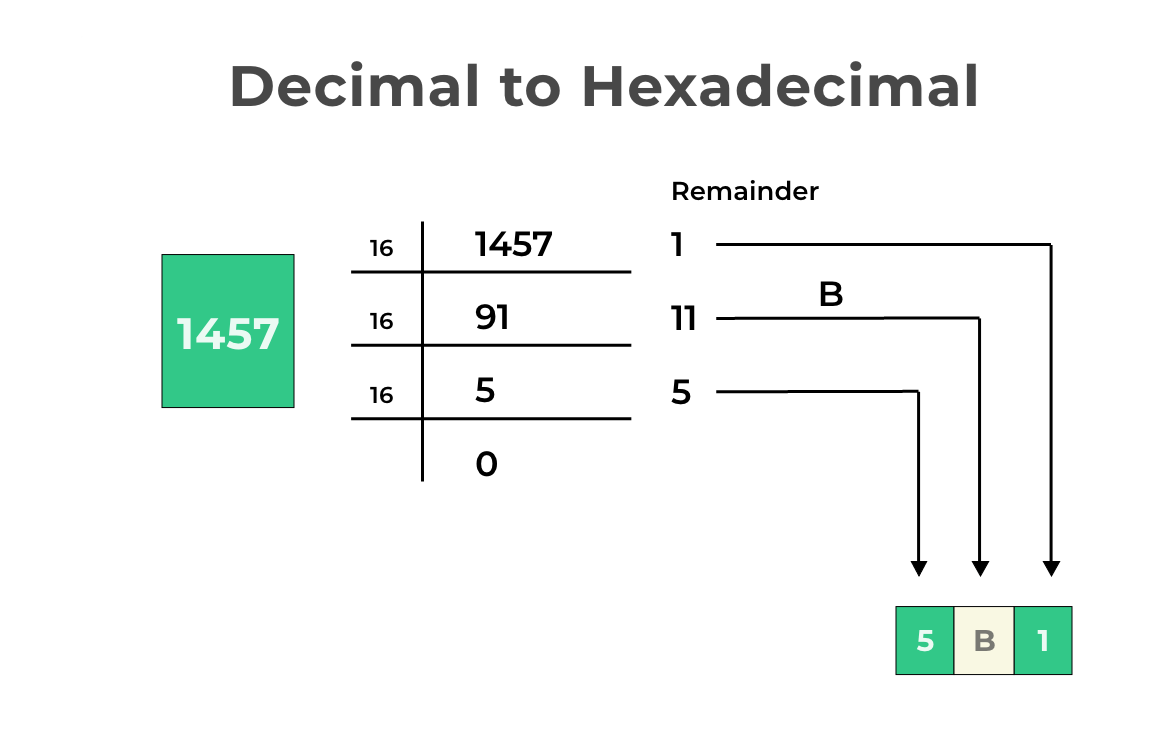Decimal To Hex
The Decimal to Hex Converter tool allows you to convert decimal numbers into hexadecimal (hex) format, providing an accurate and instant translation of your input. This tool is perfect for developers, engineers, students, and anyone working with digital systems who needs to convert decimal data into a readable hex format. The process is straightforward and efficient, ensuring precise conversions every time.
Share on Social Media:
Best Decimal to Hex Conversion Methods Explained
Need to convert a decimal to hex? This guide will take you through the process step by step. Learn the basics, see examples, and get practical tips.
Key Takeaways
The hexadecimal system is based on 16 symbols (0-9 and A-F), making it more compact and efficient for digital data representation compared to the decimal system, which is based on 10 symbols (0-9).
Decimal to hexadecimal conversion involves distinct methods: using integer division for whole numbers, multiplication for fractional numbers, and combining both techniques for mixed numbers.
Various tools and resources, such as conversion tables and online calculators, are available to assist in quickly and accurately converting decimal numbers to hexadecimal, simplifying the process for users.
0 Introduction
Have you ever wondered how the numbers you enter into your computer transform into actions, images, or commands? At the heart of this magic lies the process of decimal to hexadecimal conversion. This transformation is crucial in the world of computing and programming, where it serves as an efficient way to represent values and communicate with digital systems.
But what exactly distinguishes the decimal and hexadecimal systems? The key difference lies in their bases: decimal is based on 10, using digits 0-9, while hexadecimal extends to 16, incorporating letters A-F to represent values 10-15. Each hexadecimal digit encapsulates four binary digits, making it a compact and powerful system for conveying digital data.
Understanding Decimal and Hexadecimal Systems

Embarking on the decimal to hex conversion journey requires a foundational understanding of the two numeral systems involved. The decimal system, deeply rooted in our everyday counting and arithmetic, operates on a base-10 structure, utilizing the familiar digits 0-9. In contrast, hexadecimal expands this palette to 16 distinct symbols by including the first six letters of the English alphabet, A-F, alongside the decimal digits. This base-16 system is not just a random choice; it aligns perfectly with binary values, where each hex digit represents a group of four binary bits.
This alignment underscores why converting decimal to hexadecimal—and vice versa—is a frequent task in the computing and digital realms.
Step-by-Step Guide to Convert Decimal to Hexadecimal

Now, let’s demystify the conversion process that turns a decimal number into its hexadecimal counterpart. Whether dealing with whole numbers, fractions, or a mix of both, the methods involve simple arithmetic operations tailored to the structure of the base-16 system. Ready to unlock the secrets? Proceed to the following detailed guides.
Converting Whole Numbers
When converting whole decimal numbers, the process unfolds through integer division by 16. Start by dividing your number by 16 and note the remainder—it becomes part of your hex result.
For example, let’s convert the decimal number 960. Here are the steps to convert it to hexadecimal:
Divide 960 by 16 to get 60 with no remainder.
Divide 60 by 16 to get 3 with a remainder of 12, which corresponds to the hex digit ‘C’.
Divide 3 by 16 to end up with zero and a remainder of 3.
Now, piece these remainders together in reverse to unveil the hexadecimal result: 3C0.
Converting Fractional Numbers
Fractional numbers require a slightly different approach: multiplication by 16. Here’s how you can convert a fractional number to hexadecimal:
Begin with the fraction and multiply it by 16.
The integer part of the result is your first hexadecimal digit.
Take the fractional part and multiply it by 16 again for the next digit.
Repeat this cycle until the fractional part is reduced to zero or you’ve reached the desired precision.
By following these steps, you can convert fractional numbers to hexadecimal.
Converting Mixed Numbers
Mixed numbers blend the strategies for whole and fractional numbers. Here’s how to convert a mixed number to hexadecimal:
Divide the whole number part by 16, recording remainders as before.
For the fractional part, multiply by 16 and take the integer part as the next hex digit.
Continue this for the fraction until you’re satisfied with the precision or the fractional part vanishes.
The final hexadecimal representation is a fusion of the results from both parts, separated by a decimal point for clarity.
Decimal to Hexadecimal Conversion Table

A conversion table is a convenient tool for quickly translating between decimal and hexadecimal values. It provides a visual guide for numbers typically encountered, allowing users to bypass the manual conversion process for these specific cases. For instance, the table shows that the decimal number 14 corresponds to the hex digit ‘E’, while 255 becomes ‘FF’.
Such tables are particularly handy for double-checking conversions of numbers less than 16 or for frequent reference.
Examples of Decimal to Hexadecimal Conversion

To solidify your understanding, let’s explore some illustrative examples of decimal to hexadecimal conversion. Seeing the process in action provides insight into the mechanics and nuances of the conversion, paving the way for you to tackle numbers of your own.
Simple Whole Number Conversion
Consider the simple conversion of the decimal number 20. Divide 20 by 16, yielding a quotient of 1 and a remainder of 4. Dividing the quotient, 1 by 16, gives a final remainder of 1. Thus, the hexadecimal equivalent is ‘14’. It’s the clarity of this process that makes it a foundational skill for anyone delving into the digital world.
Complex Number Conversion
Complex decimal numbers follow the same principles but require more steps. Take the decimal number 1429 as an example. Divide by 16 to get a quotient of 89 and a remainder of 5. Continuing, 89 divided by 16 leaves a remainder of 9, and a further division of the quotient 5 gives a remainder of 5. The last decimal digit of the hexadecimal result is then ‘5’, which represents the decimal value of the original number.
These examples illustrate the versatility of the conversion method across various number sizes.
Practice Problems
After absorbing the conversion process, it’s time to apply your knowledge. Here are some practice problems to challenge your skills. Try converting the decimal number 1542 to hexadecimal or finding the hexadecimal equivalent of 175.
Solutions to problems like these reinforce your learning and build confidence in your conversion abilities.
Common Mistakes and Tips
Even with a clear understanding of the process, it’s easy to slip up during conversion. A typical pitfall is reversing the order of hex digits or misplacing remainders. Remember, the order is crucial: the remainders noted during division must be read in reverse to arrive at the correct hexadecimal number.
To avoid these and other errors, reinforce the association of decimal values 10 to 15 with their hexadecimal counterparts, A to F.
Applications of Hexadecimal System
The hexadecimal system’s role extends beyond conversions; it’s fundamental in various facets of technology. Programmers often use hexadecimal to define memory addresses or represent binary code in a more readable format. In web design, hexadecimal value is the language of color, defining shades and tints with precision, while the hex value serves as a specific representation of those colors.
Even digital electronics lean on hexadecimal for simplifying complex binary-coded values.
Tools for Decimal to Hexadecimal Conversion
For those seeking a more automated approach, numerous online tools can facilitate the conversion process. Websites like PagesTools.com, CalculatorSoup, and BinaryHexConverter offer intuitive interfaces for converting decimal numbers to hexadecimal with a few clicks, acting as efficient to hex converter tools.
Additionally, Decimal To Hex by PagesTools.com provides a user-friendly platform for quick conversions.
Summary
Reflecting on our exploration, the journey from decimal to hexadecimal conversion is both enlightening and essential. This skill not only connects us to the inner workings of technology but also empowers us to navigate the digital landscape with greater fluency. Embrace the challenge and wield this new knowledge with confidence, knowing that each step in the conversion is a step towards mastery.
Frequently Asked Questions
Why is hexadecimal used in computing instead of decimal?
Hexadecimal is used in computing because it corresponds neatly with binary, making it easier for humans to read and write binary-coded values. This simplifies the conversion process.
Can any decimal number be converted to hexadecimal?
Yes, any decimal number can be converted to a hexadecimal number, regardless of its size.
How do I convert decimal numbers less than 16 to hexadecimal?
Simply use a conversion table to find the hexadecimal equivalent for decimal numbers less than 16.
What is the hexadecimal equivalent of the decimal number 10?
The hexadecimal equivalent of the decimal number 10 is 'A'.
Are there any tools available to simplify decimal to hexadecimal conversion?
Yes, there are many online tools available to automatically convert decimal numbers to hexadecimal the best tool is PagesTools.com